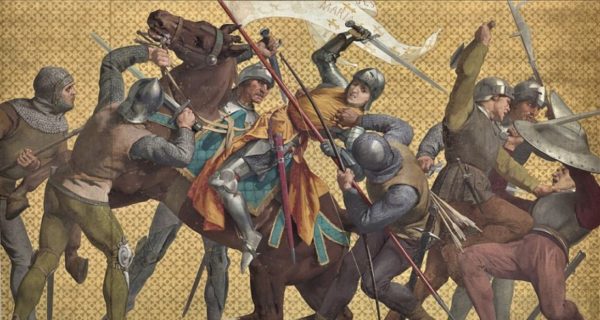A couple of months ago, my two eldest signed up for lessons in medieval broadsword techniques at our local grange. The instructor had studied extensively in Europe and was on fire for the subject – a veritable walking encyclopedia of medieval mayhem. After a week or so of watching them, I caught the bug, jumped in and also started taking instruction.
The appeal of a sword needs hardly be explained – the popularity of the Lord of the Rings and Game of Thrones is obvious everywhere – and of course, history buffs can understand the excitement of learning to actually do something you’ve only read about. The romance of the past is never far from people’s hearts. In the early weeks of classes, images of Sir Galahad, Aragorn, and Inigo Montoya’s quick footwork danced through my head. A vision of Joan of Arc riding at the head of the king’s armies beguiled my days of hum-drum housework.
Naturally, the reality was somewhat different. Just like with any martial art, there are lots of different blocks and cuts to memorize, and I’m not very coordinated. Or aggressive, as it turns out, which means my sparring skills are definitely sub-par. This last revelation was a bit of an eye-opener for me, as I thought I had a lot of pent-up frustration and anger and that this kind of activity would be a good way to channel that. So maybe it’s a good thing to find out I’m not as “tough” as I’d thought I was.
Overall, it wasn’t much of a surprise to find that this activity, like any skill, was harder than it looked from the outside. I’d been anticipating that, and the whole point was to challenge myself a bit, anyway. What I hadn’t foreseen was the picture of the past as painted by the instructor during one of his talks about how various pieces of equipment evolved. He was brandishing something called a “warhammer”, which sounds as destructive as its name and is basically a weaponized can-opener.
As I sat with my two eldest, listening attentively while the instructor waxed eloquent about how this item was used to defeat a warrior in a full suit of armor, we were struck by the ingenuity and the brutality behind all of these weapons. The savagery and the pain must have been incredible. I could almost smell the heavy miasma of blood that must have hung over a typical battlefield. The confusion and terror experienced during actual combat must have been intense. After the talk, my son was adamant that if he’d lived back then, he’d have joined a monastery rather than risk being sent to war. We laughed but were all a bit subdued. The romance of the past and the ideals of chivalry had taken a backseat to reality. For a while, the shining image had been tarnished with bloodstains.
The immediate agony of the wounds suffered in that kind of combat, the prolonged pain of permanent infection or maiming that our ancestors endured is hard to fathom. Not that wounds suffered in modern warfare aren’t also tragically horrific, but there is something more viscerally threatening about a blade or a lance or a mace than a gun or bomb. Perhaps that’s why Christ chose to be born when He’d face scourging and crucifixion, rather than a firing squad.
And yet every bit of suffering humanity undergoes – whether endured 500 years ago or last week, whether an organic illness or a tragic injury, whether of the body or the spirit – is worthy of being redeemed and uplifted by a conscious uniting with that Suffering, of Suffering. Even if you’re not an active duty soldier in harm’s way or a policeman, and even if there isn’t actual physical suffering in your life at the moment (may God bless and continue to keep you!), the lessons learned can be applied anywhere. The romance of the past is “romantic” for a reason, chivalry is not dead, not when every event in life can be deliberately transmuted and made exciting and worthwhile by our intentions. Because we know the battle between good and evil is real, and we all have the chance to be knights donning the armor of God’s grace and wielding the sword of Truth if that’s what we want deep down inside, even if we’re just getting up and going to work.
We can be Joan of Arc rallying the troops when we’re getting the family ready for Mass on Sunday morning.
